Learn about the history of play schemas, why they are important, how they align with the Montessori philosophy and get fun activity ideas.
Transporting, positioning, connection, transforming, orientation, trajectory, rotation, enveloping, and enclosure are all covered in this article.
At the bottom of the post, we've included a free PDF download of all of the play schemas and their activities.
- What Are Play Schemas?
- History of Schemas of Play
- Why Are Play Schemas Important?
- How do Play Schemas align With Montessori?
- Different Schemas in Play
- What is a Connection Schema?
- What is an Enclosure/Containing Schema?
- What is an Enveloping Schema?
- What is an Orientation Schema?
- What is a Positioning Schema?
- What is a Rotation Schema?
- What is a Trajectory Schema?
- What is a Transforming Schema?
- What is a Transporting Schema?
- Play schemas PDF
- Frequently asked questions
What Are Play Schemas?
In layman’s terms, play schemas are repeated behaviors that children demonstrate through play, which facilitate development.
There are many different definitions of schema, each varying in context. Merriam-Webster defines schemas as “mental codification of experience that includes a particular organized way of perceiving cognitively and responding to a complex situation or set of stimuli.”
Dictionary.com has a simpler definition: “an underlying organizational pattern or structure; conceptual framework.” In this article, we will refer to them as play schemas.
In child development, Swiss Psychologist Jean Piaget (1952) defined schema as: “a cohesive, repeatable action sequence possessing component actions that are tightly interconnected and governed by a core meaning.”
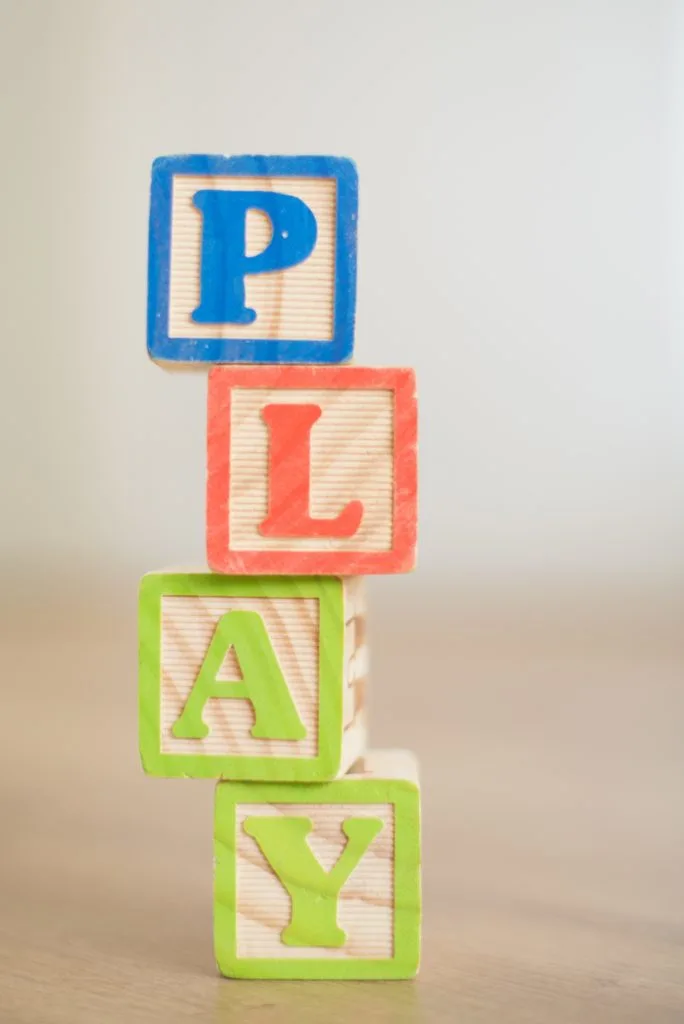
History of Schemas of Play
Jean Piaget was one of the first to use the term “schema” or “schemata” in 1923.
Piaget was one of the most important child development Theorists and his Theory of Cognitive Development was and still is incredibly influential.
He was one of the first who believed children think differently than adults and that they have an innate desire to learn, and do so by constantly taking in information from the world around them.
A major piece of his Theory of Cognitive Development was schemata. He theorized that children have three schemata: Symbolic Schemata, Operational Schemata, and Behavioral Schemata.
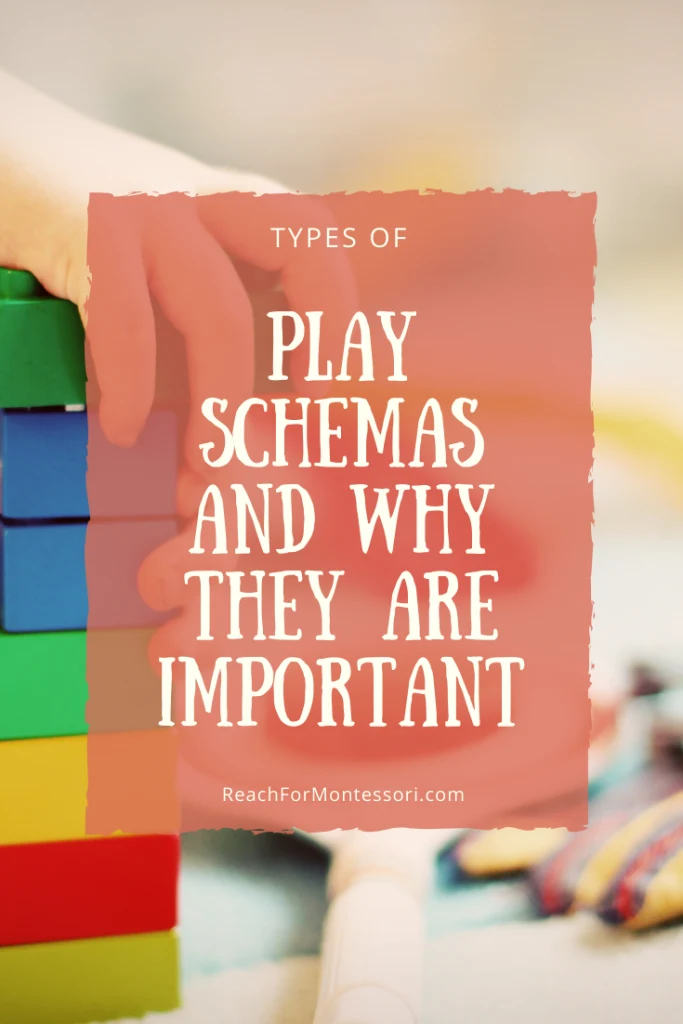
We will be focusing on what he defined as Behavioral Schemata, and what people refer to today as Play Schema, as those are the ones we see in action.
Over the last 90-100 years, the theory of schemas has been further studied and developed by numerous professionals.
Along with Piaget, British Psychologist Frederic Bartlett was one of the first to discuss schema.
He studied and wrote about schemata in his 1932 book “Remembering,” wherein he discussed schemas as they related to memory.
His research had an integral part of today’s understanding of schemas and how our brains work.
Richard Anderson, an Educational Psychologist, was one of the first people to express that understanding children’s schema could help educators.
In his 1977 paper “The Notion of Schemata and the Educational Enterprise: General Discussion of the Conference,” he discussed the importance of play schemas in education.
Chris Athey, a Constructivist Educator, further developed Piaget’s theories and the need for understanding play schemas in education.
She was the director of the Froebel Early Education Project in the 70s which was an important study in understanding the way young children think.
One aspect of this study involved discussing play schemas with parents and observing what behaviors they exhibited at home.
Why Are Play Schemas Important?
It’s important that Psychologists understand schemas to understand the brain, and for educators to understand their students and for adapting curriculum, but it’s also incredibly useful for parents.
Understanding that a particular behavior is really an uncontrollable urge and that they are learning while doing it can be helpful in more ways than one.
Sometimes your child may be exhibiting an undesired behavior that may be frustrating, but really they are in a particular play schema.
For example, one very common behavior in the toddler age is throwing food, plate, or silverware off their high chair or the table.
Understandably, it’s frustrating and we want to correct them.
However, they are experimenting while in the trajectory schema.
Believe it or not, they’re learning with every drop or throw.
Not only are they learning cause and effect, but they are discovering how different things fall at different speeds, how they all make different sounds, how they can drop or throw things, and that changes the result, even how it feels different in their hands as they’re dropped.
Once you have an understanding of why they are doing a particular behavior, and that they aren’t simply misbehaving, it makes it easier to cope.
Then you can give them other outlets to safely explore with a more appropriate activity.
By fulfilling that urge in another way, it will hopefully curb the unwanted behaviors.
In addition, knowing your child’s interests can be helpful in planning activities that they will enjoy and that will further assist in brain development.
Not every child enjoys the same types of activities, and understanding play schemas will allow you to tailor activities to interests that may otherwise not be obvious.
Some children may not enjoy arts and crafts, but once you discover their play schema, you can plan art that will really pique their interest.
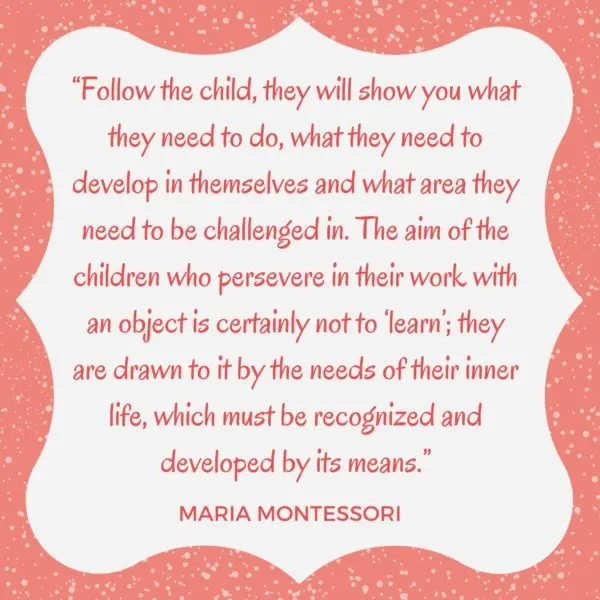
How do Play Schemas align With Montessori?
While Maria Montessori didn’t discuss schemas specifically in her teachings, she believed in child-centered learning, and that it is best to “follow the child”.
What she meant was it’s important to observe the child for their interests, skill level, and needs and plan their environment and activities accordingly.
Therefore, recognizing play schemas complement and align with the Montessori Method.
Being able to do so will assist in creating your prepared environment customized to your child.
You can also introduce different Montessori Practical Life Activities that support their schema interests.
(This post contains affiliate links. Purchasing from these links costs you nothing extra, but sends a few cents our way for website upkeep.)
Different Schemas in Play
Children start showing play schema somewhere before or around their first birthday. Some children have strong, clear schemas, others are more subtle.
Schemas can overlap, interconnect and combine over time as well. They are constantly changing and developing.
There are nine most common play schemas: Connection, Enclosure, Enveloping, Orientation, Positioning, Rotation, Trajectory, Transforming, and Transporting.
Below I explain each one and provide activities and ideas for toys/supplies for all ages.
I will also discuss what areas of learning are possible in each play schema but keep in mind it is not limited to the ones listed.
All offer opportunities for learning new vocabulary, building self-confidence, problem-solving skills, and just overall cognitive development.
What is a Connection Schema?
Joining things together, connecting objects, tying things together, opening and closing things.
This can and often includes destruction/disconnection of what they’ve connected such as knocking over blocks they’ve put together.
Real-life Example: A child finds a piece of string and starts tying or wrapping it around knobs in the kitchen, connecting all the doors together.
What Are They Learning?: Examining how things come together and apart, fine motor skills, cause and effect, spatial awareness, and pre-science and math skills, such as predicting and estimating.
Connection Schema Activities
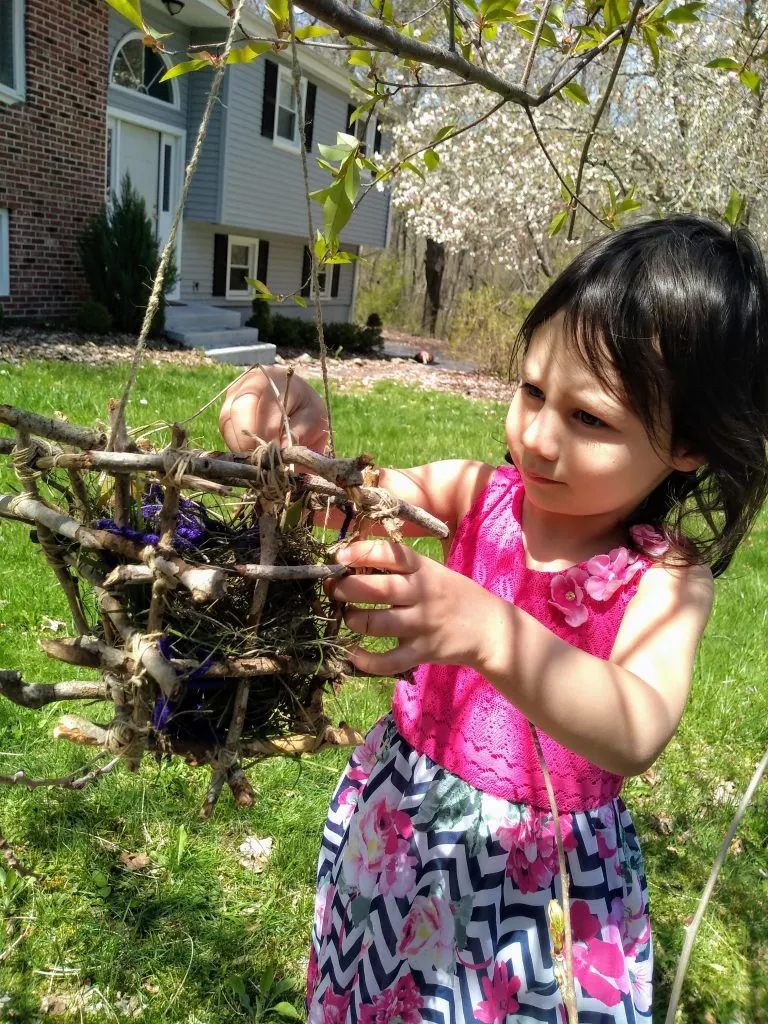
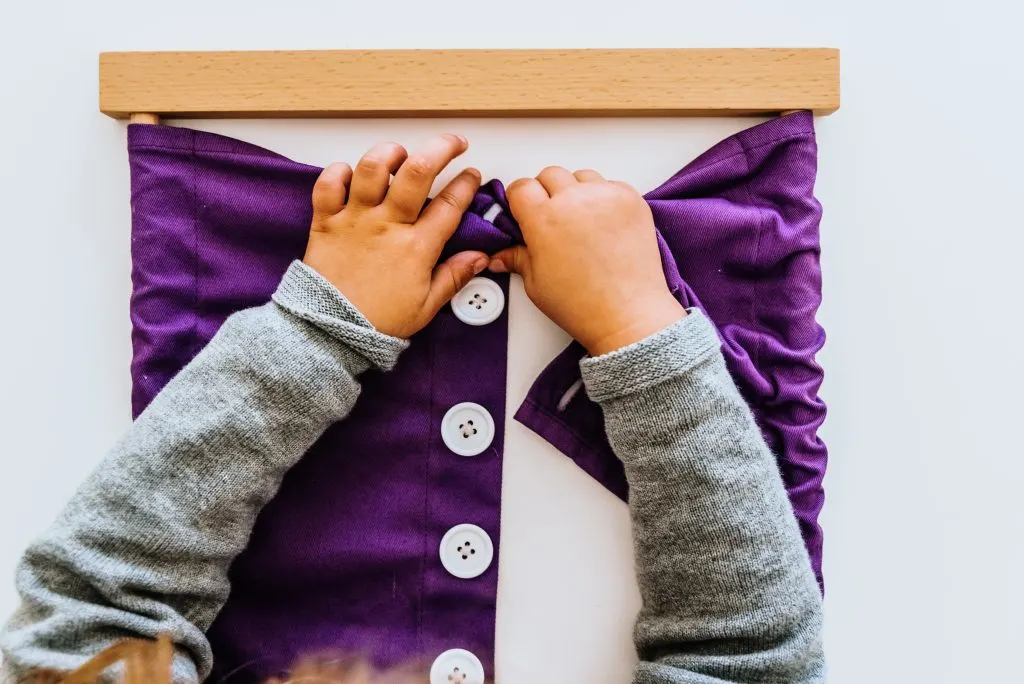
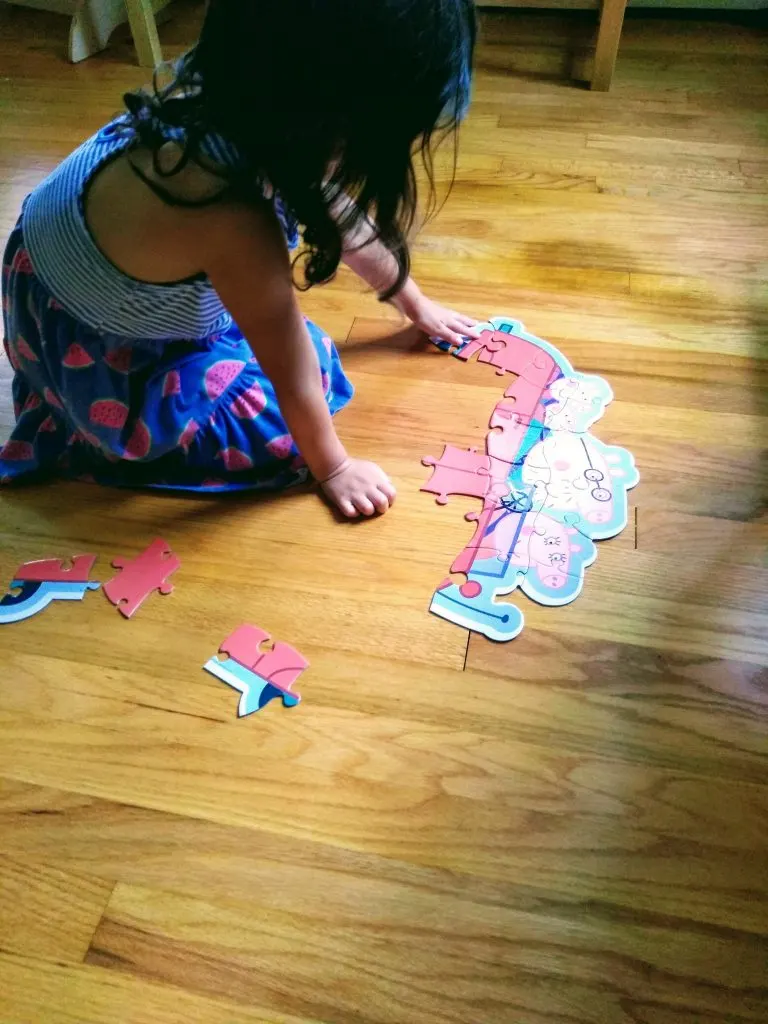
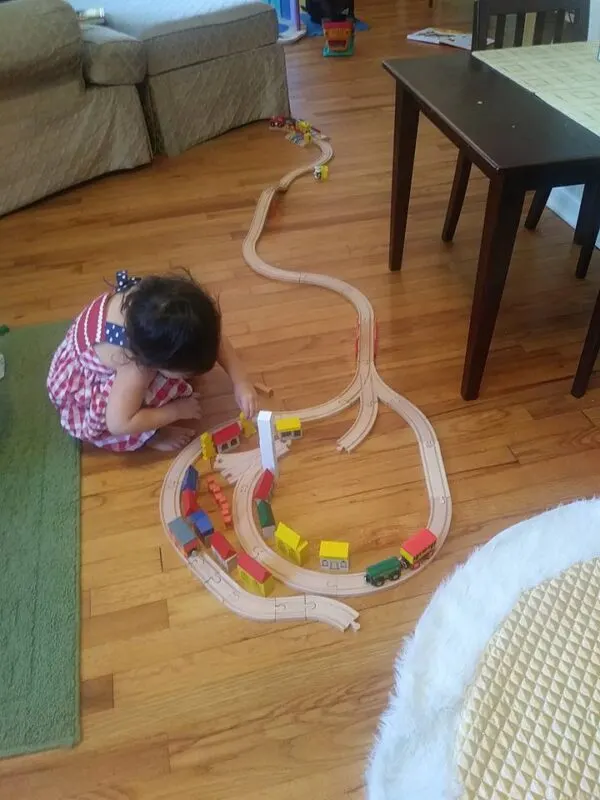
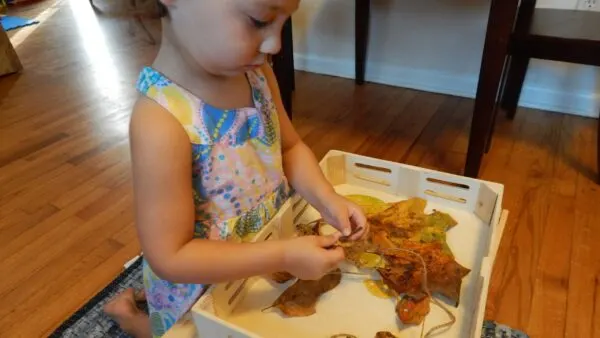
- Paper chains
- Spider webs with string
- Nesting box – Check out instructions here
- Train tracks that connect
- Pop beads
- Waffle blocks
- Bristle blocks
- Dressing boards – like these button frames
- Magnets
- Magnetic fishing game
- Jigsaw puzzles
- Lincoln Logs
- Putting marker caps on/off
- Velcro
- Containers with lids
- Cup and string phone
- Dominoes
- Locks and Keys
- Nuts and Bolts (List of nuts and bolts toys)
- Famous building pics for structure building
- Legos
- Tying Shoes
- Stickers or Tape
- Lacing Boards
- Threading leaves
- K’Nex
DIY Weaving Activity: 1. Take a baking cooling rack or something similar. 2. Tie fabric, yarn, or ribbon to the outside frame. 3. Have the child weave the ribbon through the slots.


Contact Paper Suncatchers:
1. Cut two pieces of contact paper into any shape you’d like (flower, sun, heart, etc.).
2. Make a construction paper frame & attach it to one piece.
3. Have the child stick a small piece of tissue paper on the sticky side of the contact paper.
4. When finished, have the child stick the other piece of contact paper, sticky side down, onto the finished suncatcher.
Tape Activities:
1. Give your child pieces of tape to simply stick on a piece of paper, or attach two pieces of cut paper with the tape.
2. Paint Resist Art – attach the tape to paper to create a pattern or shape and paint over. Then remove.
3. Have them help anytime you need to use tape, like wrapping presents.
Montessori Practical Life Activities for this Schema: Dressing boards, tying shoes, locks and keys, nuts and bolts, containers with lids, and lacing/weaving.
What is an Enclosure/Containing Schema?
Containing things, creating borders or lines to form enclosures, building fences/walls around objects, borders around art, lining up food around their plate, filling up cups with water.
Also includes enclosing themselves: climbing into boxes or cabinets.
Real-Life Example: A child takes all of the pots and pans out of a kitchen cabinet, then climbs in and sits down inside the cabinet. He is discovering how to enclose or contain himself.
What Are They Learning?: Building pre-math skills while planning their enclosures (measuring, predicting), fine and gross motor skills, object permanence.
Enclosure Schema Activities
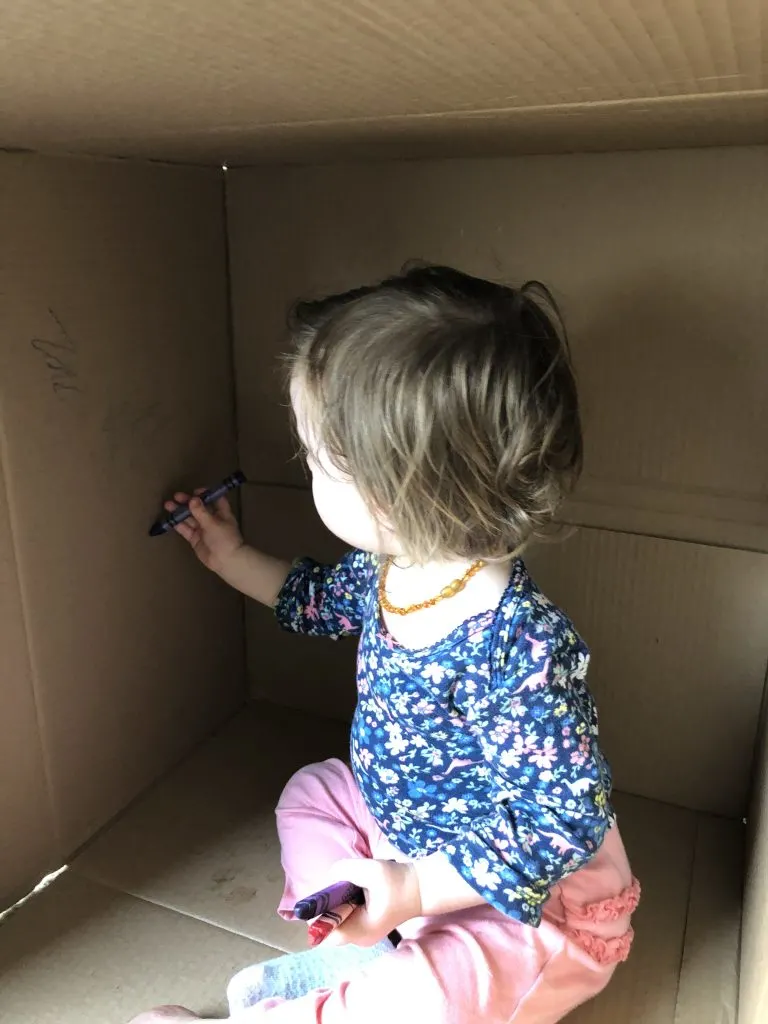
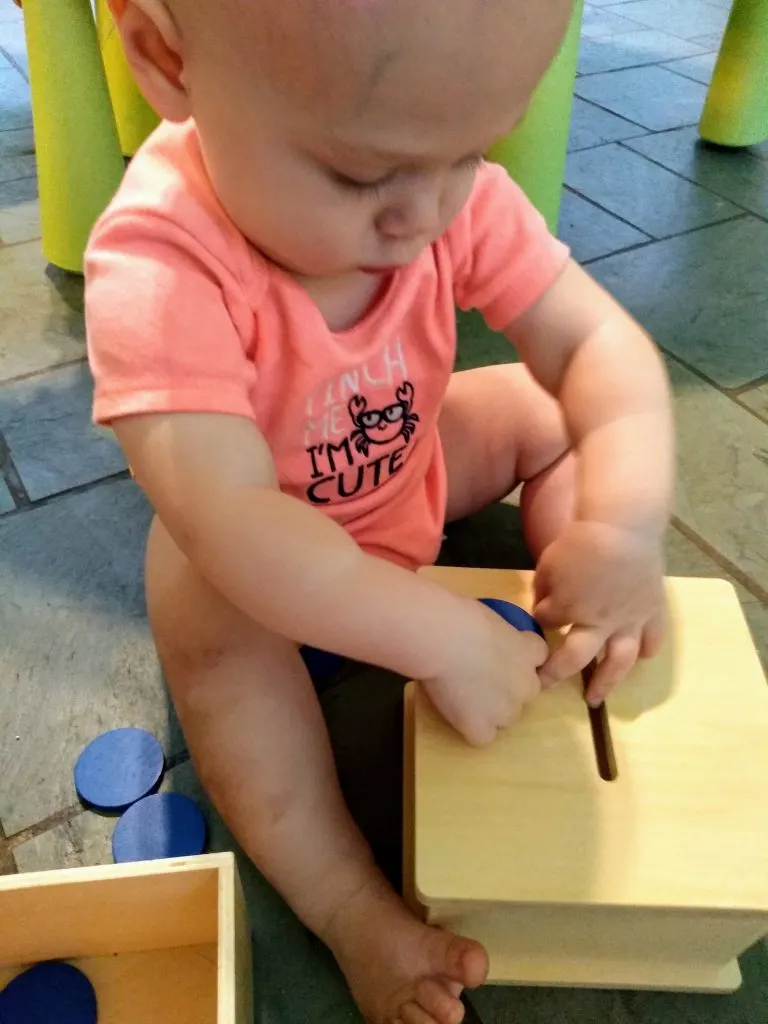
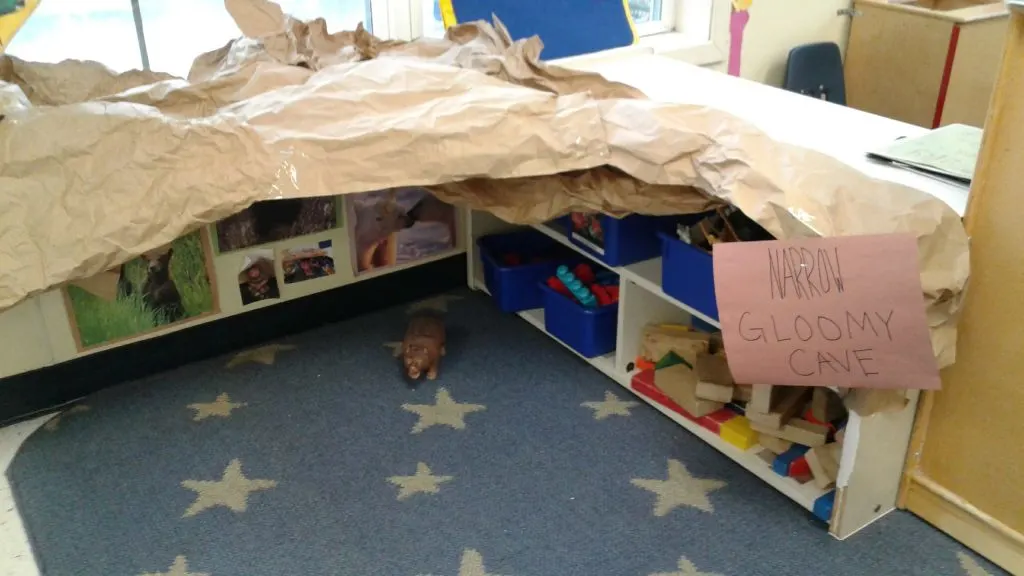
- Tents/Forts made from sheets and blankets
- Cardboard box house
- Coloring inside a cardboard box
- Clay caves/homes for animals
- Bear cave made from brown packing paper
- Shoe Box Habitats
- Hide and Seek
- Coin drop box
- Putting Groceries away
- Putting Dishes away
- Tunnel
- Building Blocks for border building
- Feely Box
- Ball Pit
- Containers with lids
- Moats and sandcastles
- Making Eggs in a Basket recipe here
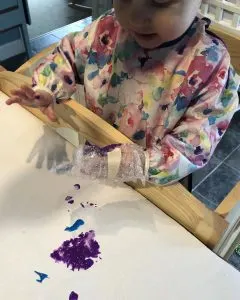
Bubble Wrap Mitten Painting:
1. Take a small piece of bubble wrap that will fit over the child’s hand.
2. Tape bubble wrap on like mittens.
3. Child paints or stamps with hands!
Framed Art:
1. Child cuts up cardboard or card stock into strips OR uses wood craft sticks.
2. Child frames their artwork.
Body Forms With Blocks:
1. Have another child or yourself lay down on the ground.
2. Child lines up blocks around the edge of the body.
3. Person gets up and you can now see the shape of the body.
Montessori Practical Life Activities for this Schema: Putting groceries or dishes away, containers with lids, making sandwiches, Eggs in a Basket.
What is an Enveloping Schema?
Covering objects or themselves, hiding things in discrete places.
They may enjoy dressing up, playing peekaboo, or even painting their entire paper or hand.
Similar to Enclosure, except with Enveloping they are covering the entire item so it cannot be seen.
Because they are similar, there are many activities listed in each that can be used for either. Enveloping may be done for comfort or safety as well.
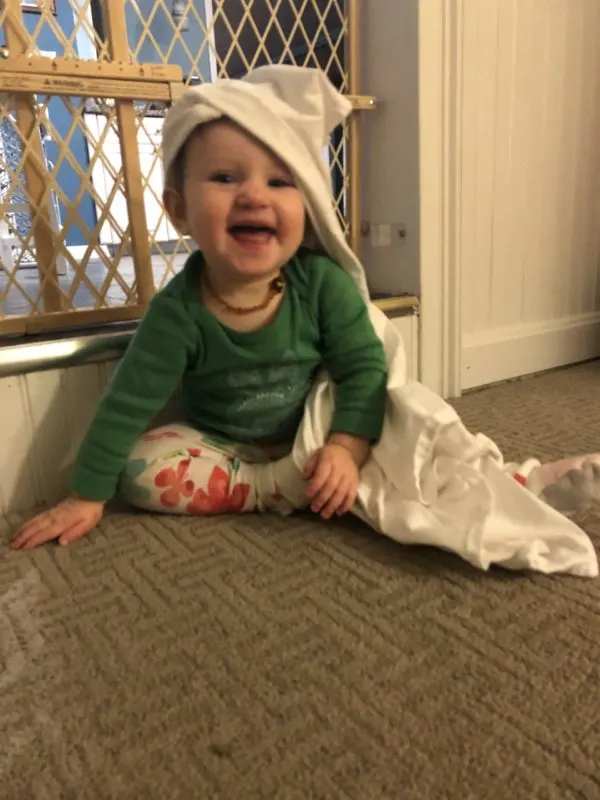
What Are They Learning?: Object permanence, fine and gross motor skills, problem-solving, visual tracking, and spatial awareness.
Real-Life Example: If there’s laundry laying around, my daughter will take whatever is there and will wrap it around her and/or put it over her head.
She will take it off and put it back on, continuing to envelop herself.
Enveloping Schema Activities
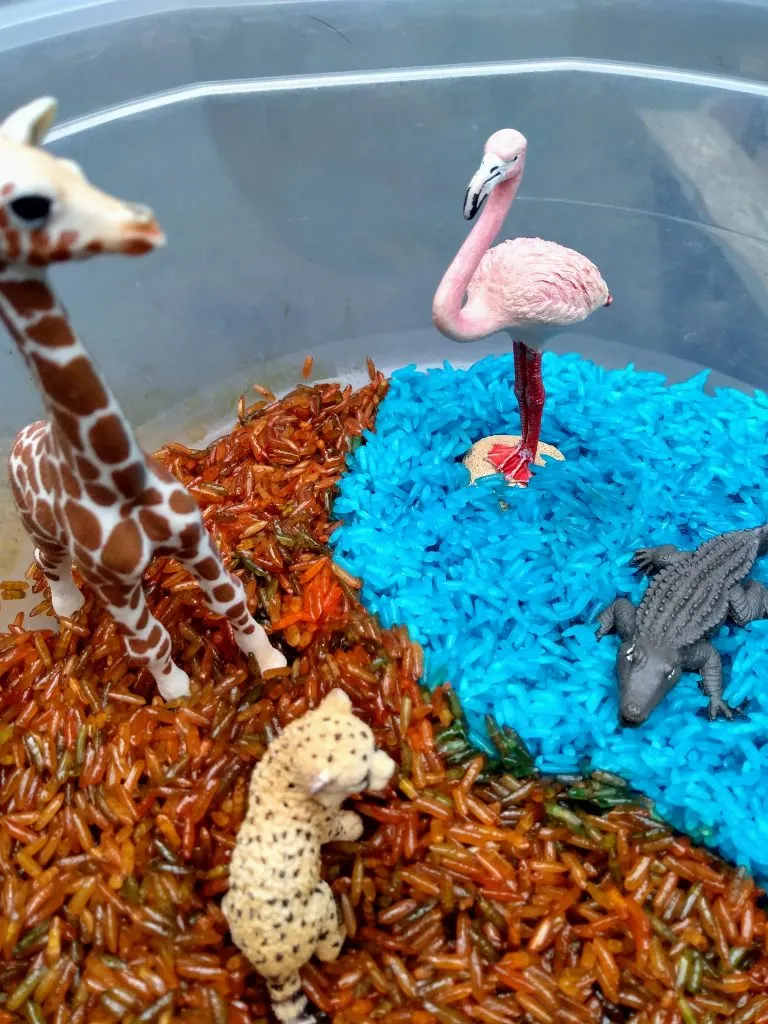
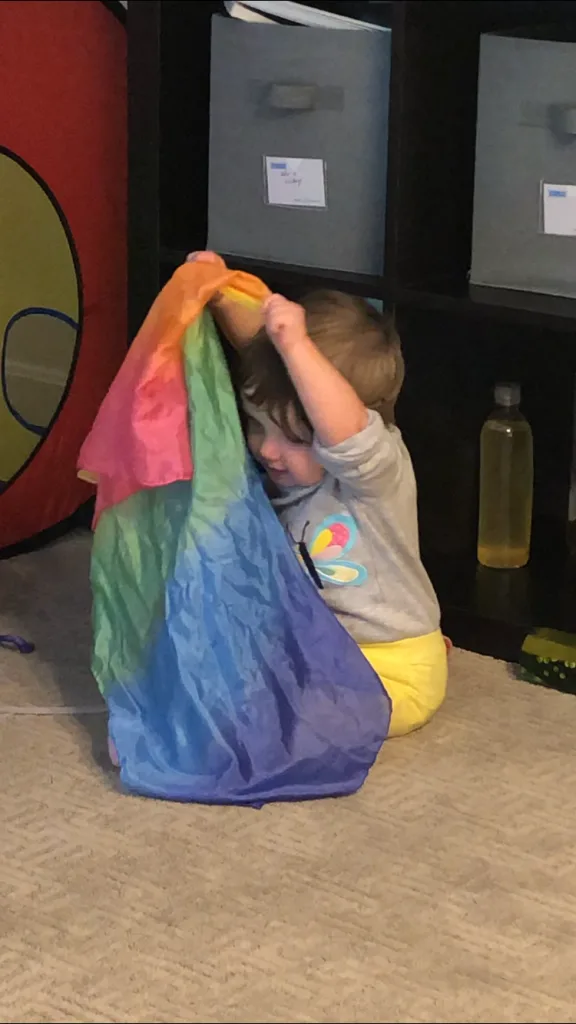
- Pikler with a blanket
- Hide toys in sand or sensory bin
- Sound Pouches & ISpy Sound Games here
- Wrapping presents
- Nesting dolls or bowls
- Dress up
- Peekaboo
- Hide and Seek
- Blankets for dolls
- Sock puppets
- Putting tablecloth on the table
- Dressing dolls
- Wooden eggs in cups
- Object permanence box
- Freezing small toys in ice
- Play silks
- Parachute games
- Baking – pies, crescent rolls, puff pastries
- Making wontons
DIY Box Activity:
1. Take several different-sized boxes.
2. Child tries to put as many boxes inside one another as possible. This activity is great for concentration, problem-solving, and keeping them busy for a while!
Papier-mâché:
1. Cut strips of newspaper or brown packing paper.
2. Make your base shape (you can use a balloon, chicken wire, aluminum foil, or cardboard boxes).
3. Make your papier-mache paste (See recipes below).
4. Dip strips of paper in the paste and start layering on your shape.
5. Allow drying.
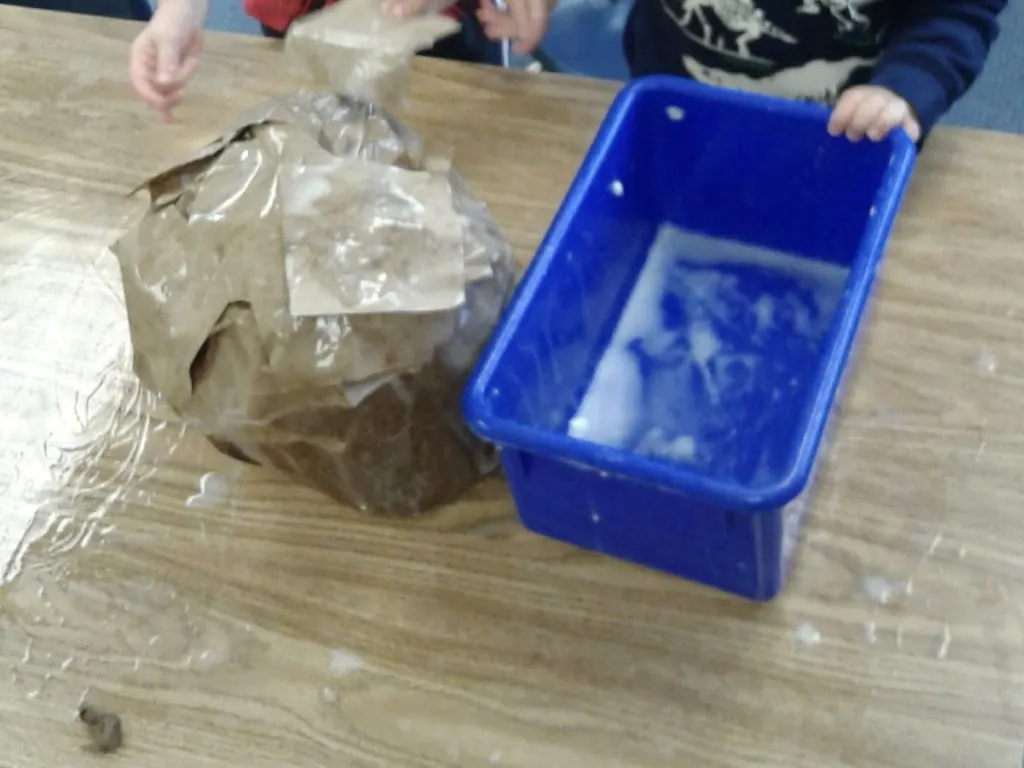
Paste recipes:
- 2 parts flour, 1 part water, then boil and stir until thick.
- 2 parts Elmer’s Glue and 1 part water (or to desired consistency).
- Or buy pre-made Elmer’s Art Paste.
Montessori Practical Life Activities for this Schema: Tablecloth on the table, dressing, wrapping presents, baking pastries, making wontons.
See also enveloping schema toys.
What is an Orientation Schema?
Experimenting with different viewpoints: hanging upside down or views from on top or under things.
What Are They Learning?: Body and spatial awareness, gross motor skills, sensory and vestibular system stimulation.
Real-life Example: A child loves hanging upside down from the couch, or bending over and looking through their legs.
Orientation Schema Activities
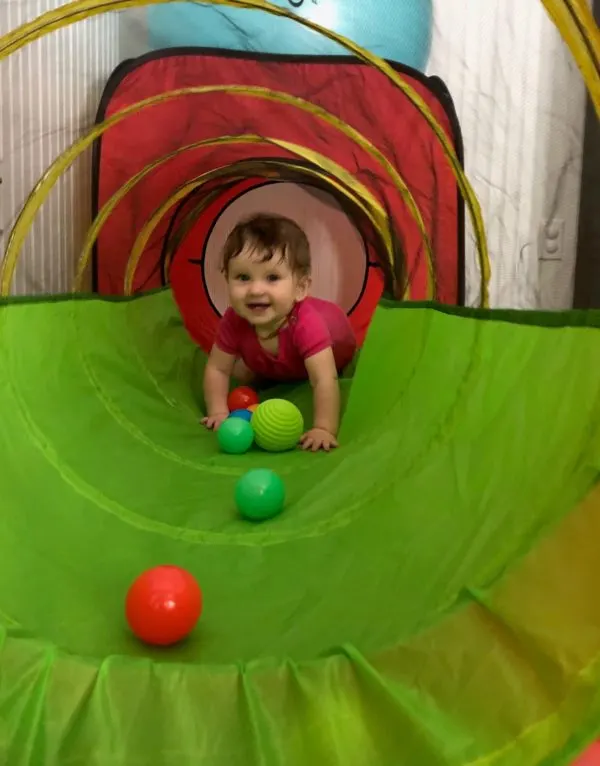
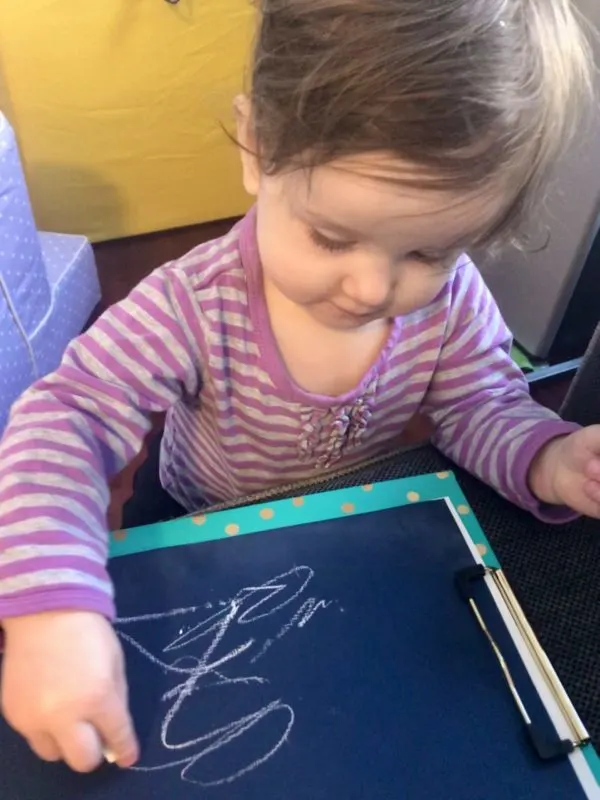
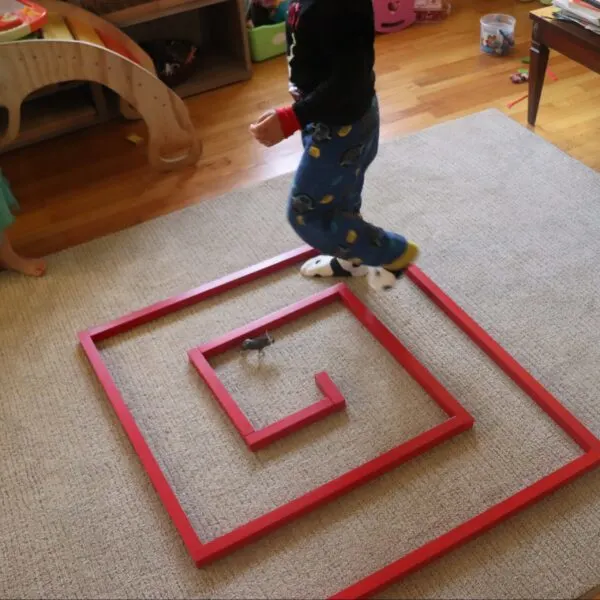
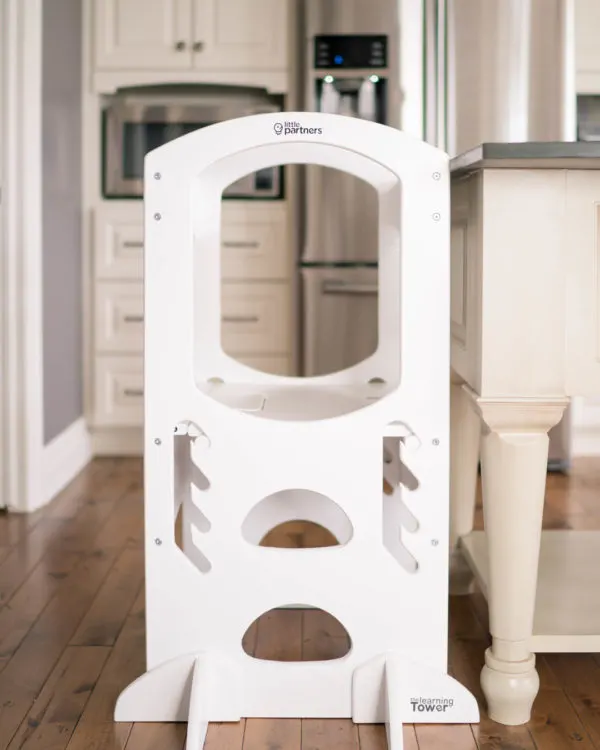
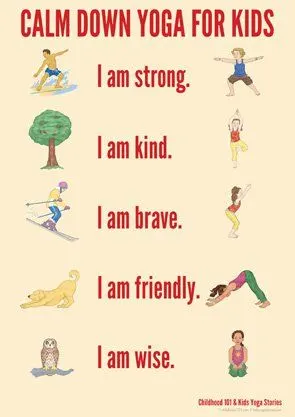
- Mirrors on floors, ceilings, or at different angles
- Yoga
- Gymnastics
- Spinning and rolling outside
- Binoculars
- Magnifying Lens
- Twister
- Climbing trees
- Walking along walls
- Jungle Gym/ monkey bars
- Kitchen Tower/Stools
- Tunnels
- Swings
- Pikler
- Sunglasses with different colored lens
- Clipboard so child can do art in different positions/places
- Red Rod Maze
- Trapeze Bar
Art Activity:
1. Tape a piece of paper underneath a child-height table or coffee table.
2. Allow the child to lay on their back and draw while laying down.
Allowing risky play is super important for this play schema.
Allowing them to get outside and explore different viewpoints by doing things like climbing things, hanging upside down from trees, and walking along rock walls can really support this play schema.
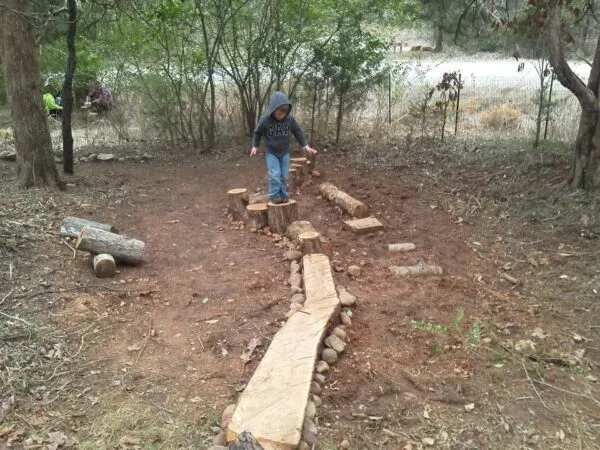
Montessori Practical Life Activities for this Schema: Kitchen Tower, yoga.
What is a Positioning Schema?
Arranging objects or themselves. Lining up items a particular way, by size, color, etc.
They might like tidying or placing things in unusual places.
Sometimes these behaviors are mistaken for a sign of OCD, but it is a normal part of development; a play schema.
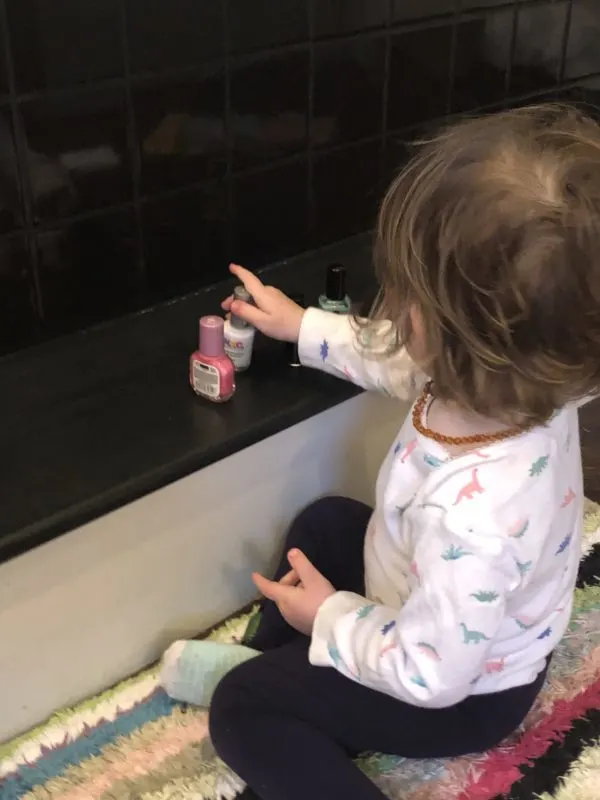
What Are They Learning?: Recognizing differences and similarities, concentration, visual discrimination, and pre-math and science skills such as problem-solving, exploring patterns, classifying, and planning.
Real-life Example: While I’m getting ready, my daughter likes to take out my nail polishes from a drawer in our bathroom and she lines them up on the step to our bathtub.
Since she hasn’t yet explored this with any other items or her toys, I let her do this under my supervision.
Positioning Schema Activities
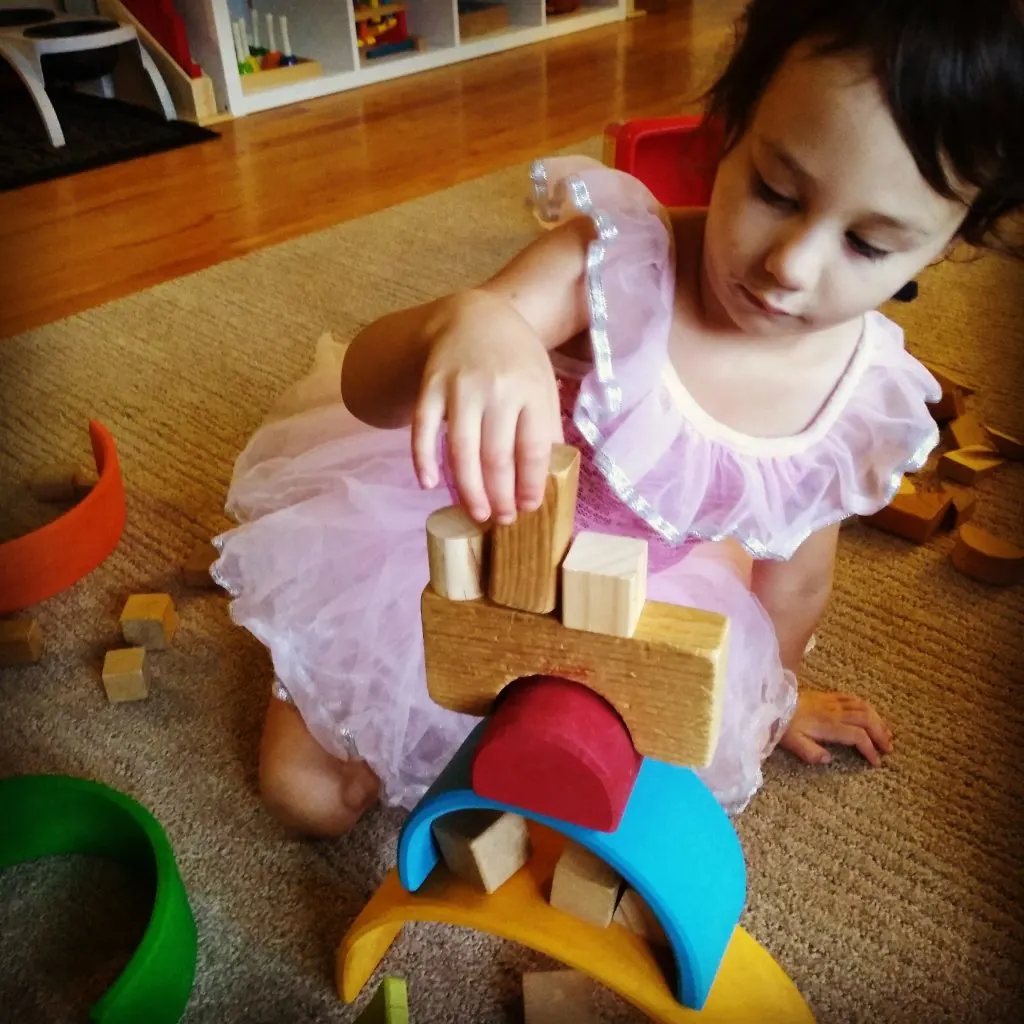
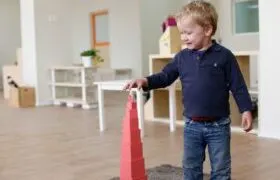
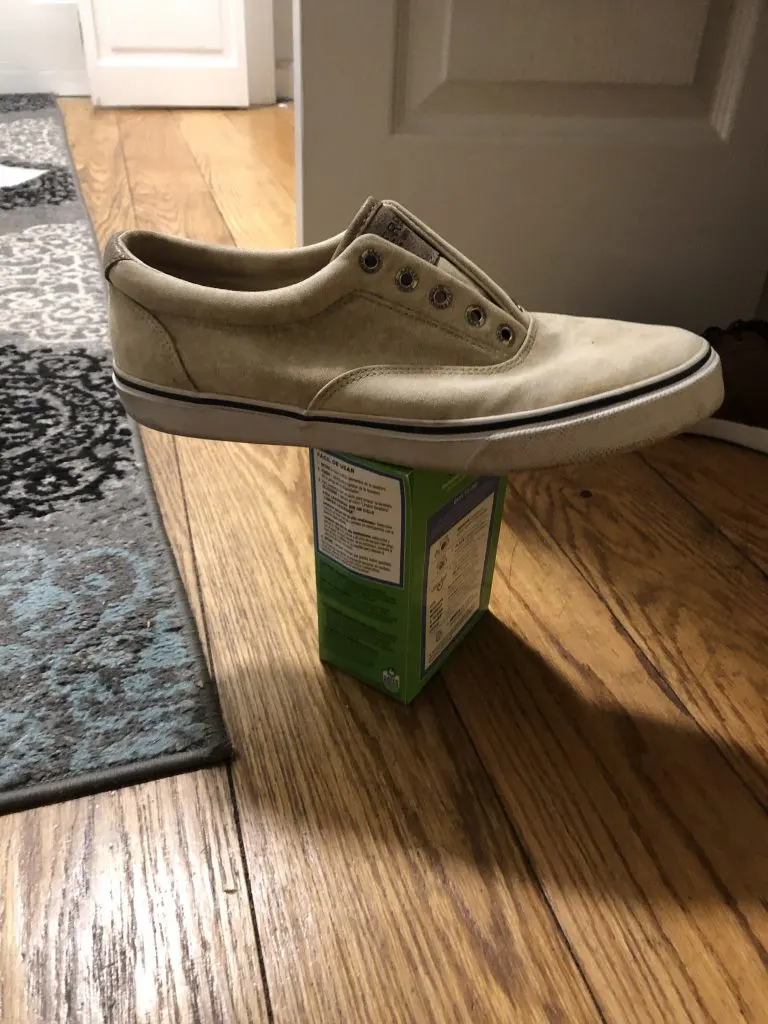
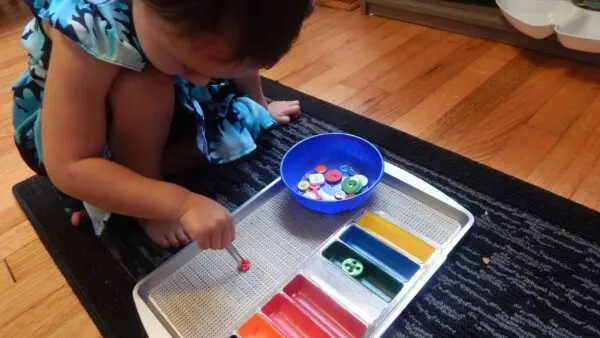
- Stacking blocks
- Grimm’s Rainbow
- Pink tower
- Balancing objects
- Peg boards (create patterns)
- 3D art (buttons, beads, shells, etc.)
- Lite Brite
- Symmetrical patterns with nature materials
- Dominoes
- Pom Pom sorting or lining up
- Sorting activities: by color, shape, size, category
- Button sorting activity here
- Flower arranging
- Matching games – like the musical instrument card game here
- Animal Parade
- Placing stickers on lines, shapes, or letters
- Trace shapes of toys and have child match toys to shape
- Knobbed cylinders
- Lining up toys and tracing their shadows
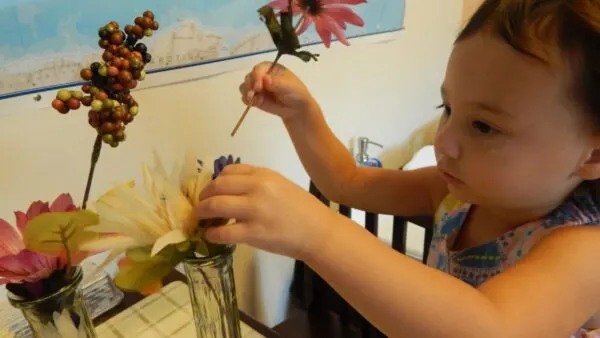
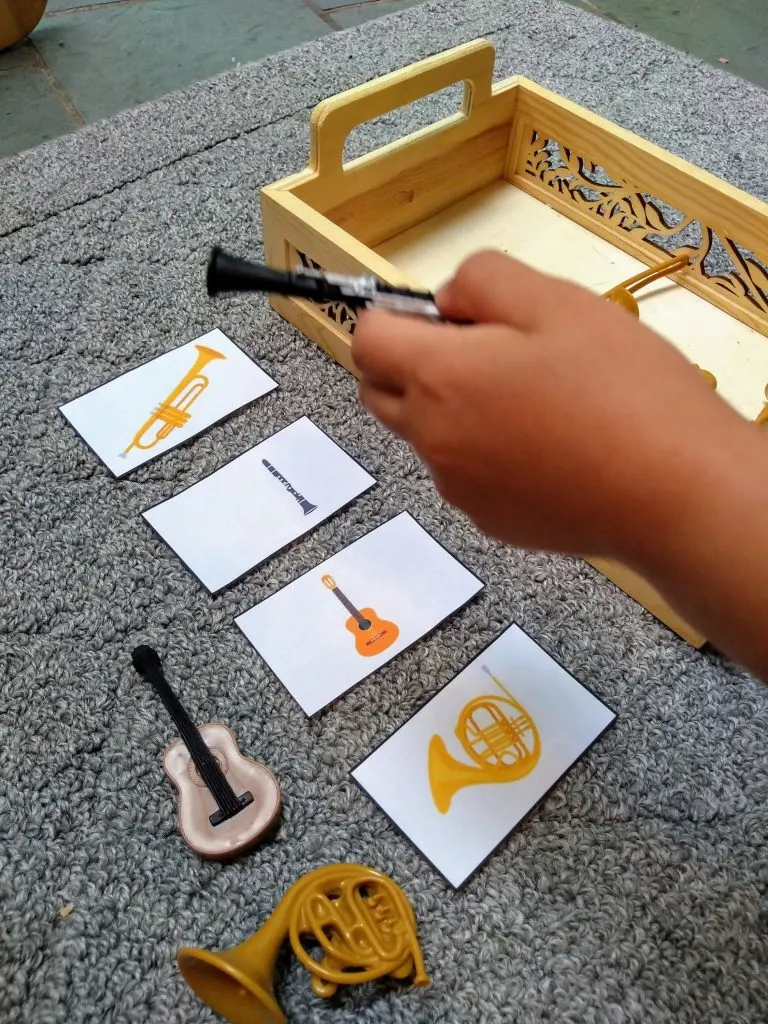
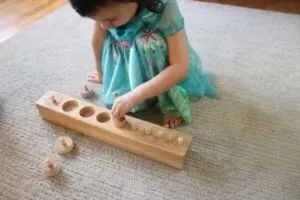
DIY Table Placemat:
1. Buy a cheap or dollar store placemat.
2. Place plate, silverware, and cup on mat and trace with permanent marker.
3. Have the child use for setting their place at the table (or make them for the whole family).
Letter or Number Activity:
1. Make large cards with letters or numbers.
2. Have the child line up small items on letters or numbers (tiny pompoms, beads, buttons, etc.).
Montessori Practical Life Activities for this Schema: Setting table, flower arranging, cleaning/tidying.
What is a Rotation Schema?
Interest in things that spin or turn. They may like spinning themselves in circles, twisting things, or drawing circles.
What Are They Learning?: How things move, fine and gross motor, cause and effect.
Real-life Example: A friend’s child, R. loves wheels and spinning things. R. was visiting my house and discovered the crank of our casement windows. He enjoyed spinning them and figuring out how and where they turned.
Rotation Schema Activities
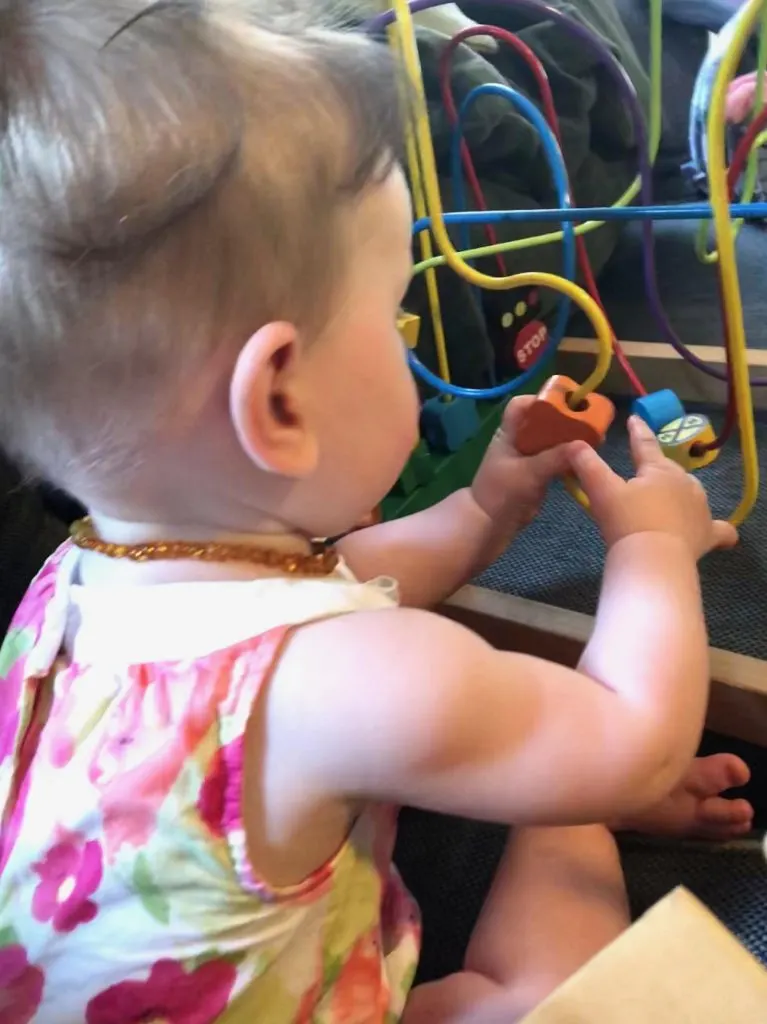
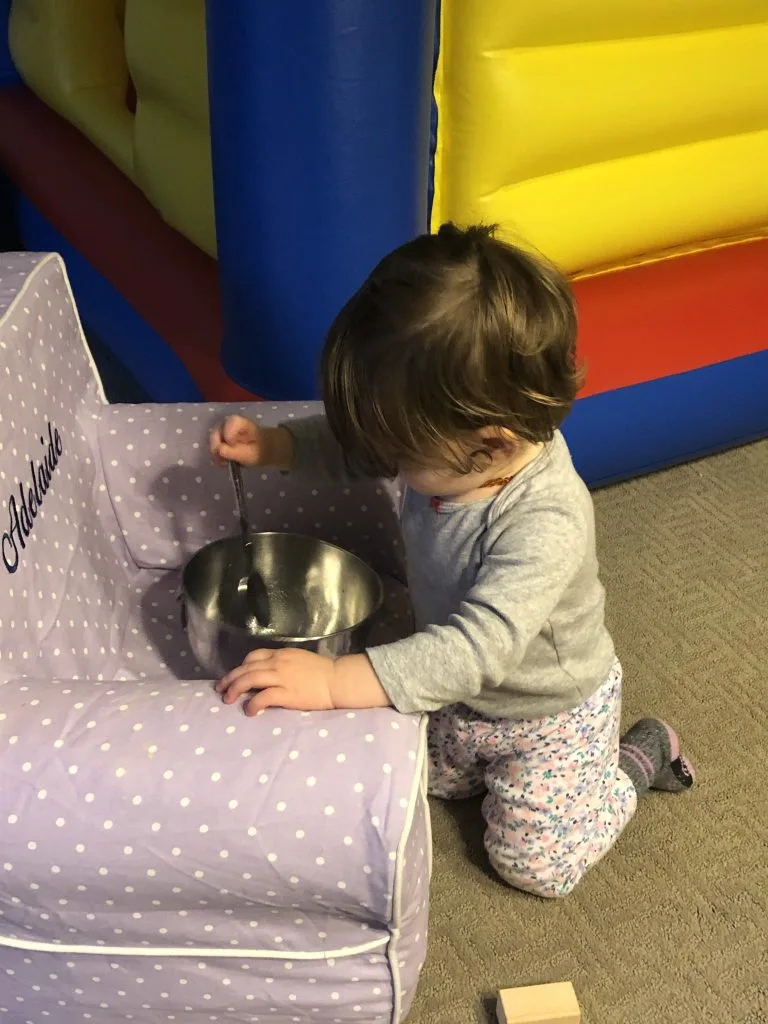
- Toy cars
- Rolling play dough
- Balls – different weights, sizes and textures
- Washing machine – have them help load and watch how it spins
- Locks and Keys
- Gears and Cogs
- Kaleidoscopes
- Spirals in nature like shells
- Mixing/Stirring
- Making pinwheels
- Spinning tops
- Paint rollers
- Rolling dough with rolling pin
- Screwdrivers
- Merry-Go-Round
- Ring Around the Rosey
- Pulleys
- Salad spinner
- Abacus
- Bangles and bracelets
- Hula Hoop
- Corks
- Wood slices
- Sit ‘n Spin
- Ball maze
- Clocks
Rotation Art Activities:
1. Taping markers to the backs of toy cars and driving them on paper.
2. Putting balls in tray or bucket with paper and paint, then rolling balls around in the paint.
3. Bubble wrap on rolling pin and rolling in paint.
4. Stamping circle shapes (paper towel rolls, lids, cups, corks).



Montessori Practical Life Activities for this Schema: Rolling dough, washing machine, clocks, mixing/stirring, salad spinner, screwdrivers, locks, and keys.
See also our list of rotation schema toys.
What is a Trajectory Schema?
Interest in moving objects by throwing, dropping, or rolling. May include the trajectory of own body by jumping off things or bumping into things.
Interacting with things that are already moving, like putting hands under running water.
What Are They Learning? Cause and effect, gross motor skills, visual tracking, body awareness, observing, and predicting.
Real-life Example: Like most infants and toddlers, my daughter experiments with throwing food and dishes off the table.
She will also do it with toys we have given her while she is standing in her learning tower.
With those things, she will watch how it lands.
Trajectory Schema Activities
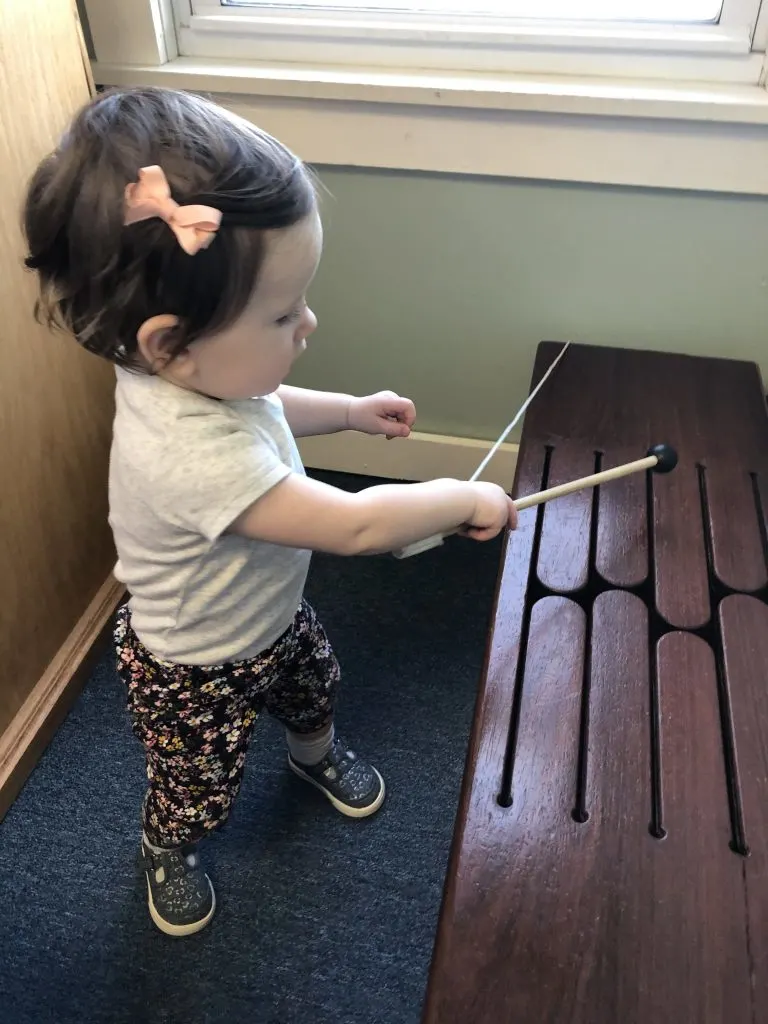
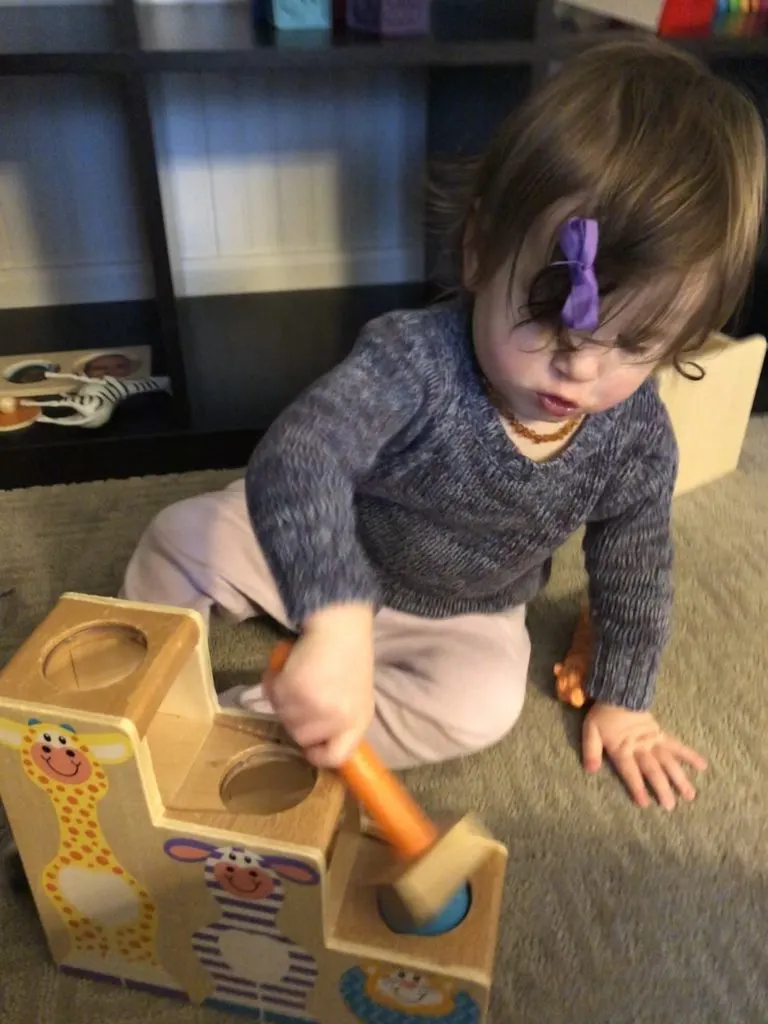
- Paper planes
- Throwing toys
- Yo-yos
- Ramps/Tubes
- Percussion
- Football and other throwing games
- Baseball
- Hammering nails
- Bowling
- Catapult
- Rockets
- Frisbee
- Kites
- Ring toss
- Slinky
- Trampoline
- Chopping food
- Pounding toys
- Bean bag toss
You may also be interested in reading about throwing toys for toddlers and specific toys for the trajectory schema.
Dropping or Rolling Experiment: Experiment by safely dropping items from different heights.
You can use different-sized balls, seeing how they bounce differently. Or just a mix of hard/soft, heavy/light objects to see how things fall at different speeds.
You can do a similar experiment with a ramp and things that roll (cars, balls, bottles, round toys).
Paint Activities:
1. Throw water balloons filled with paint on a canvas or large poster paper (best to do outside).
2. Splatter paint by snapping paintbrushes or rubber bands over a tray.
3. Spray bottle filled with watered-down paint.
4. Fill eggshells with paint and throw at a canvas or larger poster paper.
5. Drop paint as part of your experiment above.
DIY Tube and Ball Drop: Use paper towel rolls for tubes and tape them on walls at different heights and lengths.
Montessori Practical Life Activities for this Schema: Hammering nails, chopping food.
See also our list of trajectory schema toys.
What is a Transforming Schema?
Combining or changing materials. They may experiment with mixing all their food and water at meals or enjoy mixing all the paint colors during art activities.
What Are They Learning?: Cause and effect, fine motor skills, pre-science skills such as observing and predicting.
Real-life Example: My daughter loves mixing all her food together in her water cup.
She adds things and looks at them, mixes them with her utensil, and adds more.
We’ve started having her help with cooking more, specifically mixing ingredients, and I’ve noticed she mixes her meals less and less.
She also now pretends to mix things in any cup or bowl she can find.
Transforming Schema Activities
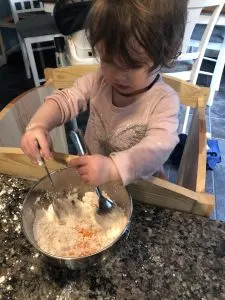
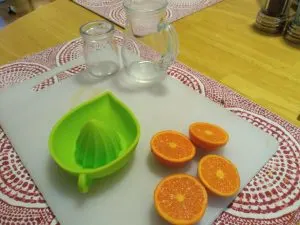
- Making dough (or really any cooking activity!)
- Tie Dye fabric
- Food coloring activities
- Shrinky Dinks
- Mr. Potato Head
- Mud kitchen
- Face painting
- Dress up clothes
- Mixing primary colors – either paint or food coloring
- Malleable materials like clay or playdoh
- DIY slime or play dough
- Powder paint
- Science experiments like baking soda and vinegar
- Melting crayons
- Making juice
- Butterfly kit
- Oobleck activities
Coffee Filter Art:
1. Using waterproof markers, the child draws on the coffee filter.
2. Child sprays water on the coffee filter with a spray bottle or squirts water on using pipettes.
3. Watch colors run and change.
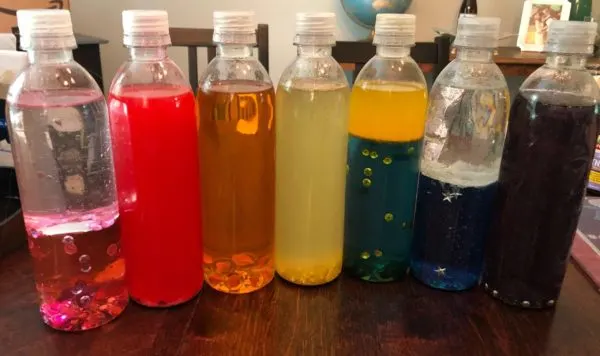
Sensory Bottles: Have the child join you in creating different sensory bottles. One of my favorites is water and oil.
Use food coloring to color water, and oil-based/candy dye for the oil.
When the bottle is shaken, the colors will combine, but then will separate again once settled.
They can continually see how the contents are transformed.
Montessori Practical Life Activities for this Schema: Dough/baking, tie-dye, making juice.
What is a Transporting Schema?
Carrying objects in pockets, hands, bags. May also enjoy transporting oneself.
What Are They Learning?: Object permanence, fine and gross motor skills, spatial awareness, planning, and measuring (how much will fit?).
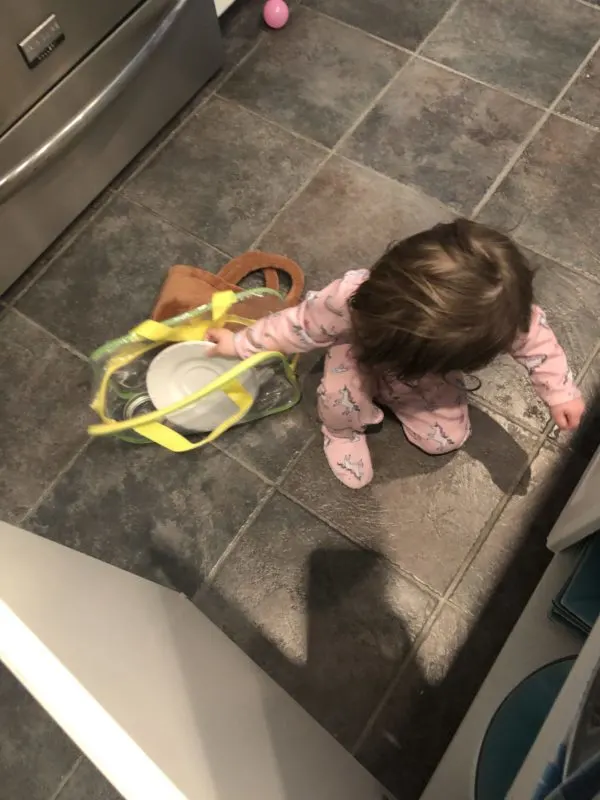
Real-life Example: Several months ago, my daughter started carrying small items around the house in her hands.
When she discovered that things can go inside of other things, she started carrying things around that way.
She would use anything she could find including the drawer of her coin dropbox, a gift bag that was laying around, and containers from the kitchen cabinet.
I started leaving a reusable shopping bag around for her and an old purse.
Since then we have bought her a toy shopping cart which she loves.
Heavy work can be a big help for a child in this play schema. Read about what it is and its benefits here.
Transporting Schema Activities
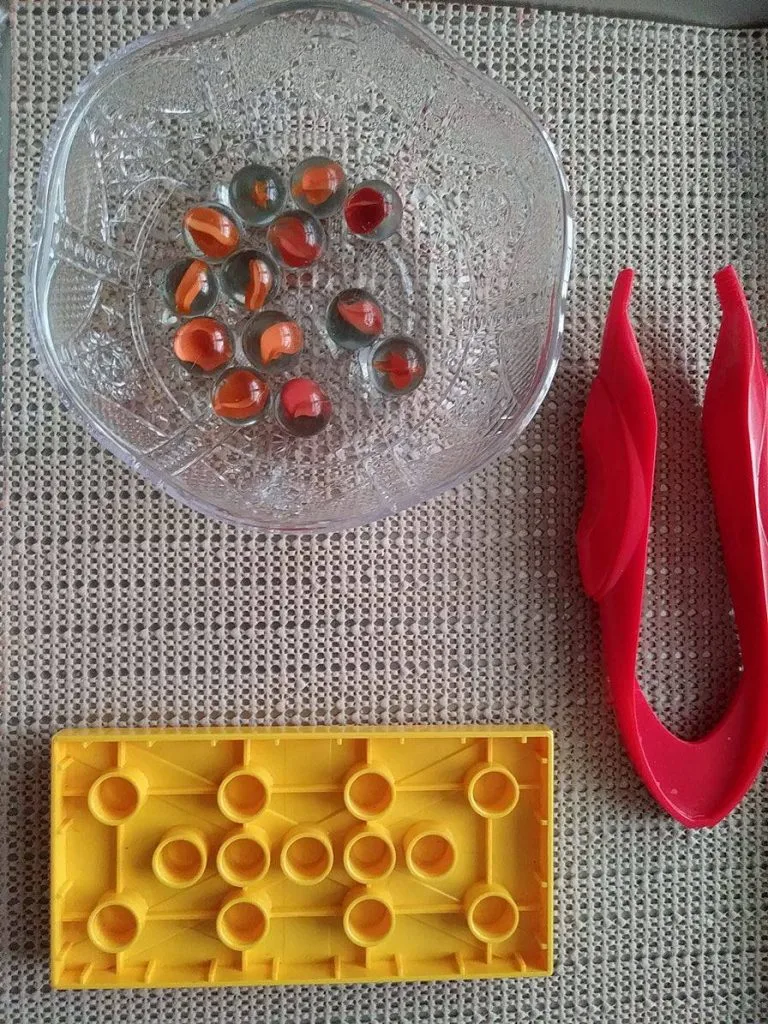
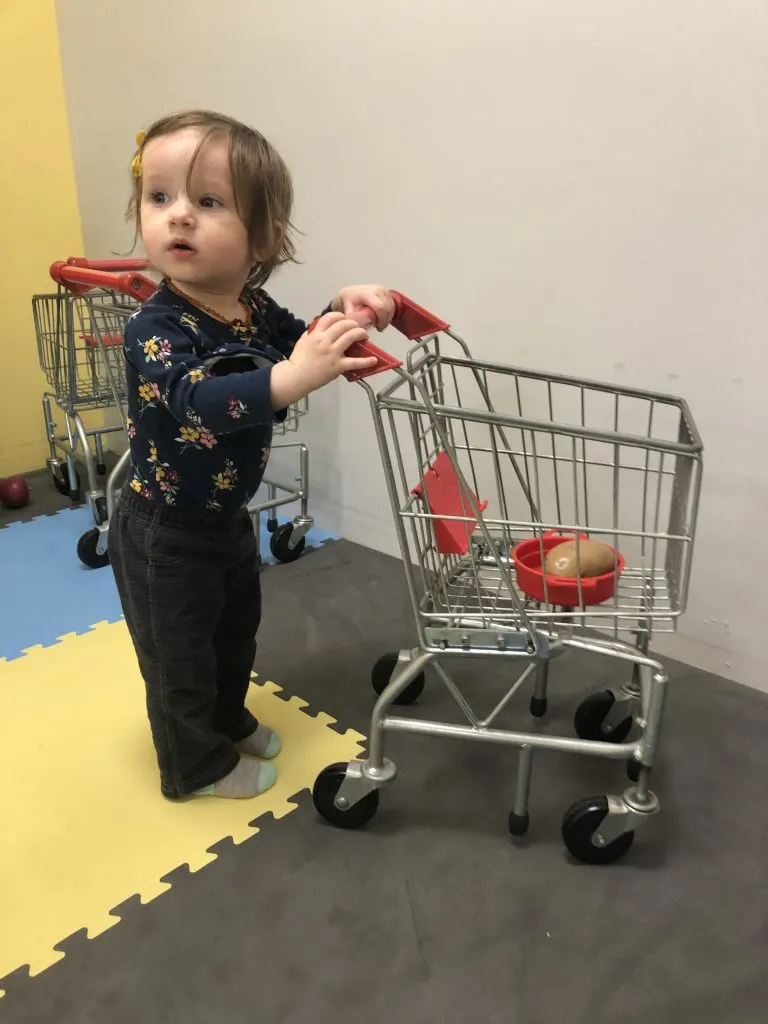
- Diggers and trucks to transport dirt/sand
- Chalk map outside for trucks, etc.
- Pipettes to fill and transfer water
- Transferring activities – like the marble activity here
- Wagons to transport friends or toys
- Cooking: Taking ingredients out for recipes/putting in oven
- Toy shopping cart
- Reusable shopping bags
- Levers and pulleys
- Baskets
- Purses
Helpful Activity: Have them help you carry anything around the house! They can carry laundry baskets, groceries in from the car, or supplies for arts and crafts to the table.
Gardening: Gardening is a great opportunity for transporting things! You can start by planting seeds in pots, where the dirt will be transported into the pot.
Once you have seedlings, have the child transport supplies to the garden and help plant them. Use a child-sized wheelbarrow to transport dirt to the garden area.
Montessori Practical Life Activities for this Schema: cooking, gardening, groceries.
See also transporting schema toys.
Children learn best when they’re able to experiment, make mistakes and problem solve. With play schemas, they have a natural urge to do these things.
By freely allowing them to explore their early childhood schemas of play, you’re supporting their cognitive development.
I hope you can now easily recognize play schemas in your child and are able to fully support their schema behaviors.
Do you have any fun activities to add to any of these play schemas? How does your child exhibit their schemas?
References and further reading:
England, L. (2018). Schemas: a practical handbook. London, UK: Bloomsbury Publishing Plc.
McLeod, S. A. (2018, June 06). Jean Piaget's theory of cognitive development. Simply psychology [Blog post] Retrieved from: https://www.simplypsychology.org/piaget.html
Arnold, C. (2005, October 19). Early years pioneers: Chris Athey. Nursery World [Blog post]. Retrieved from: https://www.nurseryworld.co.uk/features/article/early-years-pioneers-chris-athey
Cherry, K. (2019, September 23). The role of schema in psychology [Blog post]. Retrieved from: https://www.verywellmind.com/what-is-a-schema-2795873
Unknown. Learning Theory, Schema Theory [Blog post]. Retrieved from: https://education.stateuniversity.com/pages/2175/Learning-Theory-SCHEMA-THEORY.html
*Correction: In the original post, regrettably we mistakenly referred to Psychologist Jean Piaget as British, but he was in fact, Swiss. We have updated the post as of 3/2/21.
Play schemas PDF
If you want a free download of this full article and its references, just click the link below.
This play schemas PDF can be printed out or just kept on your computer or phone for reference whenever you need it.
Frequently asked questions
Play schemas are activities in play that child repeats, which help them to develop. The 9 play schemas are trajectory, connection, enveloping, enclosure, orientation, positioning, rotation, transporting, and transforming.
Children's schemas can be supported by caregivers paying careful attention to their play and other behaviors. Caregivers should provide toys and activities that support the child's current schematic need.
An example of a play schema is when a baby or toddler throws food from their tray onto the floor to observe how it lands. This is an example of the trajectory schema.

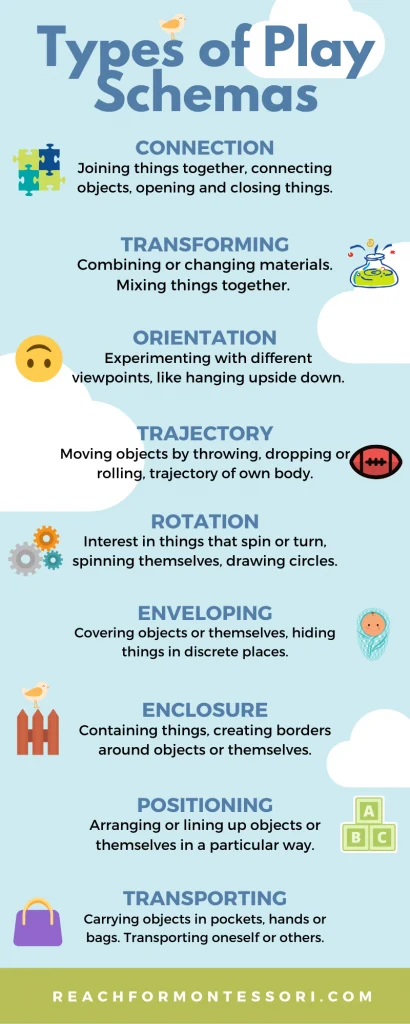
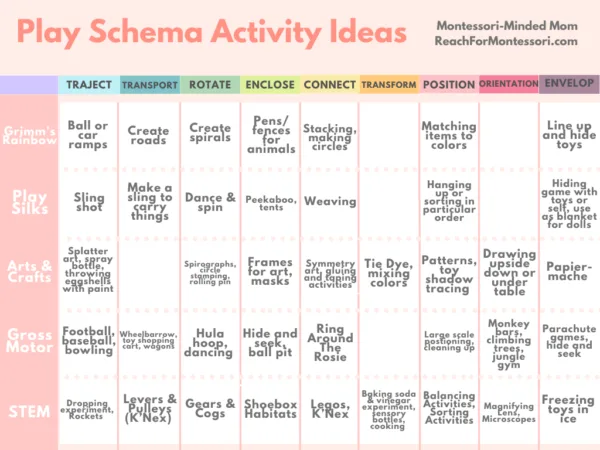
Lizz
Monday 2nd of August 2021
This the post I meant, I love all of this, thank you!
Angie arroyo
Tuesday 27th of April 2021
Interesting read and helps me understand my preschooler a lot better!
Sushma
Friday 5th of February 2021
That has been wonderful to read about different play schemas. I am totally in favor of learning through play. Like a reader above, I will really enjoy having a printable of each schema to flip through.
Lynn Armstrong
Thursday 15th of October 2020
I love your idea about the weaving with the baking racks my kids would love that. I think it would keep them busy for hours.
Stephanie
Sunday 11th of October 2020
Loved reading this. I studied education and taught for 9 years and it’s been a long time since I have read or talked about this. I’m all about play and letting my kids learn through play.